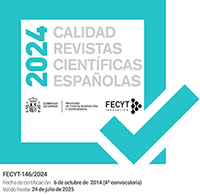Castillos, poder feudal y reorganización espacial en la Transierra madrileña (siglos XII-XIII)
DOI:
https://doi.org/10.5944/etfiii.13.2000.3649Resumen
Algunos castillos de la Transierra madrileña en los siglos xii y xiii son herederos de los husün musulmanes, pero se convierten en esa época en centros de poder señorial sobre unas débiles comunidades. No obstante, sólo su transformación en concejos permitirá la supervivencia de algunos de ellos, aunque se observa también un desplazamiento del habitat hacia el llano, resultado de la formación de un nuevo sistema productivo basado en la agricultura cerealfstica y la propiedad feudal, por lo que el papel de los castillos es limitado. En las zonas serranas su relevancia es aún menor y nunca estructuraron el paisaje, labor que ejercieran los sexmos de la Tierra de Segovia.
Some castles of the Madrid's Transierra in the xii"" and xiif" centuries are inheritors of the muslim husün, but they viere converted during this age in centres of a lordship power which was imposed to the weak communities. However, only some of them could survive through their conversión In town counciis (concejos), although there is also an habitat's displacement to the plain, that is the result of the new producing system based on the grain agrículture and the feudal property, so the role of the castles was reduced. In the mountain áreas the landscape was never structured by castles, but by the rural distrícts (sexmos) ofthe Segovia's Land.
Descargas
Descargas
Publicado
Cómo citar
Número
Sección
Licencia
Los autores que publican en esta revista están de acuerdo con los siguientes términos:
- Los autores conservan los derechos de autor (copyright) de las obras publicadas y garantizan a la revista el derecho de ser la primera publicación del trabajo al igual que permiten la reutilización del mismo bajo la licencia de uso indicada en el punto 2.
- Las obras se publican en la edición electrónica de la revista bajo una licencia Creative Commons Reconocimiento-NoComercial 4.0 Internacional, que permite a otros compartir el trabajo con un reconocimiento de la autoría del trabajo y de la publicación inicial en esta revista. Se pueden copiar, usar, difundir, transmitir y exponer públicamente, siempre que: i) se cite la autoría y la fuente original de su publicación (revista, editorial y URL de la obra); ii) no se usen para fines comerciales.
- Se permite y se anima a los autores a difundir electrónicamente las versiones pre-print (versión antes de ser evaluada) y/o post-print (versión evaluada y aceptada para su publicación) de sus obras antes de su publicación, ya que favorece su circulación y difusión más temprana y con ello un posible aumento en su citación y alcance entre la comunidad académica (por ejemplo, en repositorios institucionales o en su propio sitio web). Color RoMEO: verde. (Véase The Effect of Open Access) (en inglés).
Authors who publish in this journal agree to the following terms:
- Authors retain copyright and grant the journal right of the first publication with the work simultaneously licensed under a Attribution-NonCommercial-NoDerivatives 4.0 International, that allows others to share the work with an acknowledgement of the work's authorship and initial publication in this journal.
- Authors are able to enter into separate, additional contractual arrangements for the non-exclusive distribution of the journal's published version of the work (e.g., post it to an institutional repository or publish it in a book), with an acknowledgement of its initial publication in this journal.
- Authors are permitted and encouraged to post their work online (e.g., in institutional repositories or on their website) prior to and during the submission process, as it can lead to productive exchanges, as well as to earlier and greater citation of the published work (See The Effect of Open Access).








